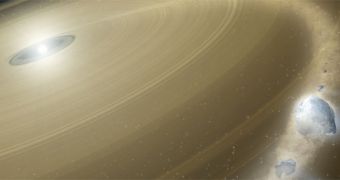Scientists have recently determined that its possible for white dwarfs to grow by accreting medium-sized celestial bodies such as protoplanets called planetesimals. These space bodies can even contain water in concentrated forms, astronomers say.
The discovery was made as experts were investigating the ways in which exoplanets can be discovered. One method is to look at the absorption spectra of parent stars, as the bodies pass in between the cosmic fireballs and Earth.
Another technique is to chemically analyze the atmosphere of white dwarfs in binary systems, or that roam the Universe all by themselves. Looking at their light can reveal whether they accrete mass, or if they did so recently.
On these helium stars, a physical phenomenon called convection is pulling all the heavy chemical elements cannibalized from another star to the core of the structure, leaving the photosphere pure.
These stellar layers are generally almost entirely made up of hydrogen and helium. If astronomers manage to discover signs of any other chemicals, then it means that the white dwarf consumed something in the recent past.
In a new scientific study, researchers returned to a 2008 paper, which dealt with the traits of a white dwarf called GD61. The recent study shows that the object is not only consuming dust and small bodies, but also structures as large as planetesimals, Universe Today reports.
Using data collected in 2009 by the NASA Spitzer Space Telescope, an infrared observatory, researchers were able to determine that the dust disk around the white dwarf extended for a distance of about 26 stellar radii away from the star.
This setup was consisted with a scenario in which the white dwarf had just attracted a large cosmic object to its surface, and then used massive tidal forces to break it apart. As such, the debris rings around GD61 may in fact be made up of the remains of a water-containing planetesimal.
Investigations conducted with the HIRES spectograph on the Keck I telescope revealed that the original object which was broken apart must have been around 100 kilometers (60 miles) in diameter.
Spectral studies of the chemicals in the disk and on the surface of the white dwarf show that the asteroid was most likely wrapped up in water or ice.
This scenario is not so far-fetched, considering the large number of water-ice bearing space rocks in our solar system, not to mention massive comets.
The new finding is bound to change the way astronomers look at white dwarf's accretion habits.

 14 DAY TRIAL //
14 DAY TRIAL //